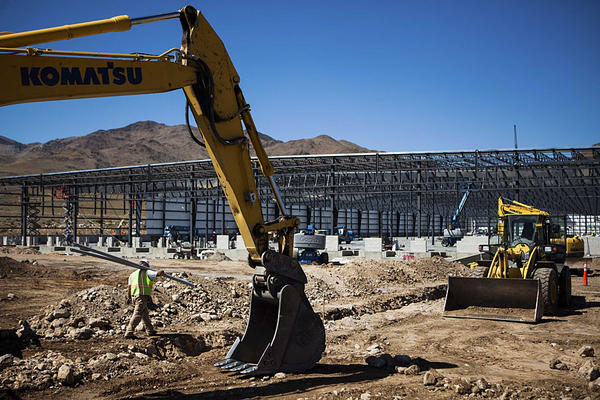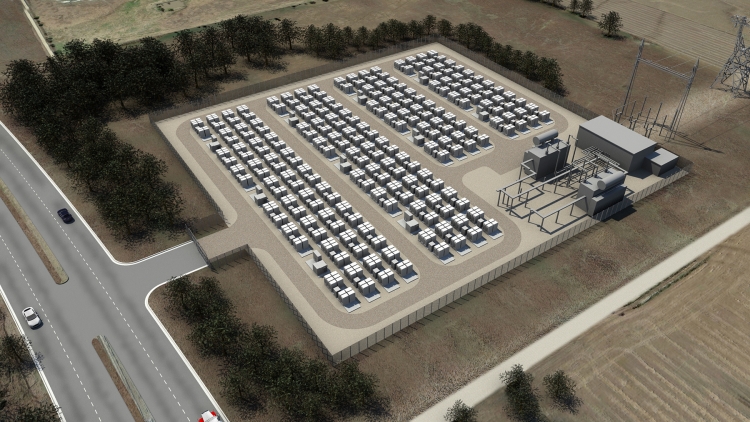News
Lithium Mining is a Hot Topic In Nevada Thanks to Tesla
Lithium mining is suddenly a hot topic in Nevada, where a local state senator is up in arms about a deal to import lithium from Mexico. Other sources exist.

Lithium mining has become a hot topic in Nevada largely because of Tesla’s interest in sourcing lithium hydroxide, one of the main ingredients needed for Gigafactory scale production of lithium-ion batteries.
Tesla announced it had signed a deal with Canadian company Bacanora and British company Rare Earth Minerals towards the end of August. Bacanora is a minerals explorer, while Rare Earth Minerals owns Sonora Lithium Project. That partnership is designed to develop a “low-cost”, “sustainable” mining project in Northern Mexico based on clay deposits found in the region.
The Sonora mine does not exist yet, but could yield between 35,000 and 50,000 tons of lithium deposits annually. The deal will be extended and scaled up contingent on the mine’s ability to meet Tesla’s forecasts and actual output from its Gigafactory. The two Sonora project partners will need to find debt or equity to finance the operation and Tesla is permitted under the deal to participate in financing activities.
The state of Nevada has agreed to give Tesla almost a half billion dollars in tax incentives in order to lure the Gigafactory to the site north of Reno, which seems little enough considering the increase in economic activity the factory will bring to the state. But now, a Nevada politician, Democrat state senator Tick Segerblom, has tweeted, “Tesla to get lithium from Mexico – where’s Trump when you need him?”
tesla to get lithium from mexico – where's trump when we need him? $TSLA http://t.co/8NGT7OgjXp via @WSJ
— Tick Segerblom (@tsegerblom) August 28, 2015
That got the Las Vegas Sun involved. They contacted Elon Musk, who tweeted back that press interest in the story was “unwarranted” as the lithium deal was “not exclusive” and had “many contingencies”. He said that Tesla would “definitely” be interested in talking to local suppliers of lithium feedstocks. According to the Sun’s sources, developing lithium mines in the US is a lengthy process taking as much as 10 years, while lithium mining operations already located in Nevada are either too small or nearing the end of their planned lifetime.
@ScottLucasNV Lithium deal is not exclusive & has many contingencies. The press on this matter is unwarranted.
— Elon Musk (@elonmusk) September 2, 2015
Now up pops Nevada Sunrise Gold Corporation, which apparently is a played out gold mining operation. It announced on September 2nd that it has “entered into a letter agreement for an option to purchase” a site in Esmeralda County, which is in Nevada’s Clayton Valley. The company believes that area could hold lithium brine deposits in subterranean aquifers, based upon studies and reports made of the local area.
Meanwhile, researchers at the University of Wyoming report they have discovered an enormous supply of lithium at the Rock Springs Uplift, a geological feature in southwest Wyoming. Initial tests indicate the lithium-rich brine from a 25-square-mile area could contain 228,000 tons of the stuff. That’s enough to meet annual U.S. demand and is twice the amount available at Silver Peak in Nevada, which is the biggest domestic lithium producer today.
What has the University of Washington team excited is that the lithium at the Rock Springs Uplift can be processed more cheaply than the lithium found at other locations, due to a number of factors.
First, extracting the lithium from brine requires large quantities of soda ash (sodium carbonate). The Rock Springs Uplift site is located within 30 miles of the world’s largest industrial soda ash supplies, so the cost of transporting it to the production area will be minimal.
Second, magnesium must be removed from brine before it can be used for lithium recovery and that can be an expensive process. The brine from the Rock Springs Uplift reservoirs is lower in magnesium than at other sites. Less magnesium means less money to remove it.
Third, the brine must be heated and pressurized to release the lithium it contains. Because the Rock Springs Uplift brine is far underground, it is already at a higher pressure and temperature than brine at existing lithium operations. That factor may eliminate an expensive step in the process, resulting in significant cost savings.
The Chinese thought they had cornered the market for lithium when they locked up rights to much of the world’s lithium supply located in Bolivia a decade ago. But apparently, the demand has created interest in new sources of supply. Hopefully, all this interest in lithium will spur competition which could lead to lower prices. And that could spell lower battery prices for the electric cars and electrical storage batteries of the future.
Source: PV-Tech

News
Tesla FSD fleet is nearing 7 billion total miles, including 2.5 billion city miles
As can be seen on Tesla’s official FSD webpage, vehicles equipped with the system have now navigated over 6.99 billion miles.

Tesla’s Full Self-Driving (Supervised) fleet is closing in on almost 7 billion total miles driven, as per data posted by the company on its official FSD webpage.
These figures hint at the massive scale of data fueling Tesla’s rapid FSD improvements, which have been quite notable as of late.
FSD mileage milestones
As can be seen on Tesla’s official FSD webpage, vehicles equipped with the system have now navigated over 6.99 billion miles. Tesla owner and avid FSD tester Whole Mars Catalog also shared a screenshot indicating that from the nearly 7 billion miles traveled by the FSD fleet, more than 2.5 billion miles were driven inside cities.
City miles are particularly valuable for complex urban scenarios like unprotected turns, pedestrian interactions, and traffic lights. This is also the difference-maker for FSD, as only complex solutions, such as Waymo’s self-driving taxis, operate similarly on inner-city streets. And even then, incidents such as the San Francisco blackouts have proven challenging for sensor-rich vehicles like Waymos.
Tesla’s data edge
Tesla has a number of advantages in the autonomous vehicle sector, one of which is the size of its fleet and the number of vehicles training FSD on real-world roads. Tesla’s nearly 7 billion FSD miles then allow the company to roll out updates that make its vehicles behave like they are being driven by experienced drivers, even if they are operating on their own.
So notable are Tesla’s improvements to FSD that NVIDIA Director of Robotics Jim Fan, after experiencing FSD v14, noted that the system is the first AI that passes what he described as a “Physical Turing Test.”
“Despite knowing exactly how robot learning works, I still find it magical watching the steering wheel turn by itself. First it feels surreal, next it becomes routine. Then, like the smartphone, taking it away actively hurts. This is how humanity gets rewired and glued to god-like technologies,” Fan wrote in a post on X.
News
Tesla starts showing how FSD will change lives in Europe
Local officials tested the system on narrow country roads and were impressed by FSD’s smooth, human-like driving, with some calling the service a game-changer for everyday life in areas that are far from urban centers.

Tesla has launched Europe’s first public shuttle service using Full Self-Driving (Supervised) in the rural Eifelkreis Bitburg-Prüm region of Germany, demonstrating how the technology can restore independence and mobility for people who struggle with limited transport options.
Local officials tested the system on narrow country roads and were impressed by FSD’s smooth, human-like driving, with some calling the service a game-changer for everyday life in areas that are far from urban centers.
Officials see real impact on rural residents
Arzfeld Mayor Johannes Kuhl and District Administrator Andreas Kruppert personally tested the Tesla shuttle service. This allowed them to see just how well FSD navigated winding lanes and rural roads confidently. Kruppert said, “Autonomous driving sounds like science fiction to many, but we simply see here that it works totally well in rural regions too.” Kuhl, for his part, also noted that FSD “feels like a very experienced driver.”
The pilot complements the area’s “Citizen Bus” program, which provides on-demand rides for elderly residents who can no longer drive themselves. Tesla Europe shared a video of a demonstration of the service, highlighting how FSD gives people their freedom back, even in places where public transport is not as prevalent.
What the Ministry for Economic Affairs and Transport says
Rhineland-Palatinate’s Minister Daniela Schmitt supported the project, praising the collaboration that made this “first of its kind in Europe” possible. As per the ministry, the rural rollout for the service shows FSD’s potential beyond major cities, and it delivers tangible benefits like grocery runs, doctor visits, and social connections for isolated residents.
“Reliable and flexible mobility is especially vital in rural areas. With the launch of a shuttle service using self-driving vehicles (FSD supervised) by Tesla in the Eifelkreis Bitburg-Prüm, an innovative pilot project is now getting underway that complements local community bus services. It is the first project of its kind in Europe.
“The result is a real gain for rural mobility: greater accessibility, more flexibility and tangible benefits for everyday life. A strong signal for innovation, cooperation and future-oriented mobility beyond urban centers,” the ministry wrote in a LinkedIn post.
News
Tesla China quietly posts Robotaxi-related job listing
Tesla China is currently seeking a Low Voltage Electrical Engineer to work on circuit board design for the company’s autonomous vehicles.

Tesla has posted a new job listing in Shanghai explicitly tied to its Robotaxi program, fueling speculation that the company is preparing to launch its dedicated autonomous ride-hailing service in China.
As noted in the listing, Tesla China is currently seeking a Low Voltage Electrical Engineer to work on circuit board design for the company’s autonomous vehicles.
Robotaxi-specific role
The listing, which was shared on social media platform X by industry watcher @tslaming, suggested that Tesla China is looking to fill the role urgently. The job listing itself specifically mentions that the person hired for the role will be working on the Low Voltage Hardware team, which would design the circuit boards that would serve as the nervous system of the Robotaxi.
Key tasks for the role, as indicated in the job listing, include collaboration with PCB layout, firmware, mechanical, program management, and validation teams, among other responsibilities. The role is based in Shanghai.
China Robotaxi launch
China represents a massive potential market for robotaxis, with its dense urban centers and supportive policies in select cities. Tesla has limited permission to roll out FSD in the country, though despite this, its vehicles have been hailed as among the best in the market when it comes to autonomous features. So far, at least, it appears that China supports Tesla’s FSD and Robotaxi rollout.
This was hinted at in November, when Tesla brought the Cybercab to the 8th China International Import Expo (CIIE) in Shanghai, marking the first time that the autonomous two-seater was brought to the Asia-Pacific region. The vehicle, despite not having a release date in China, received a significant amount of interest among the event’s attendees.









